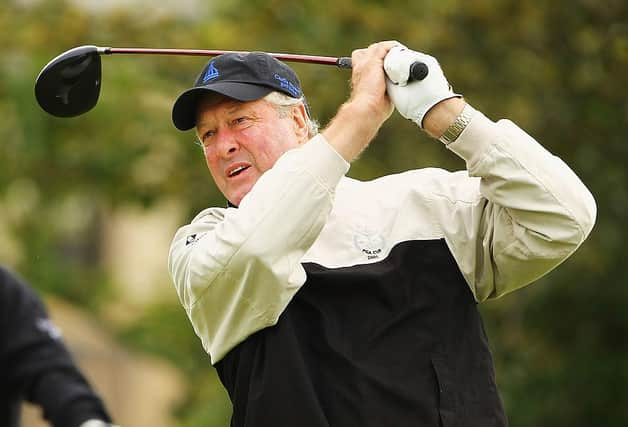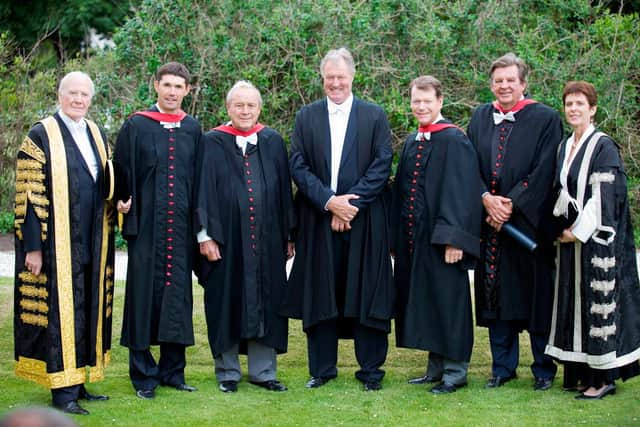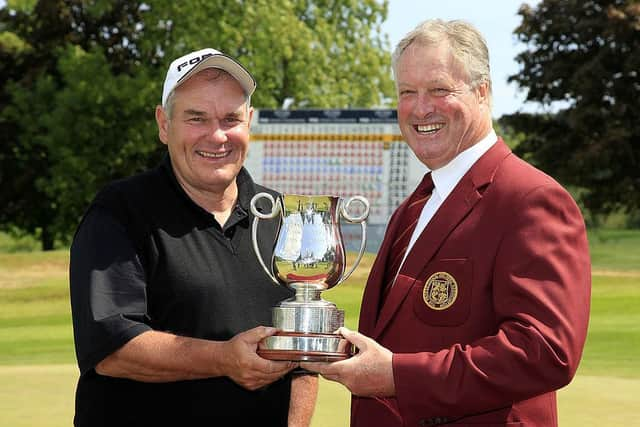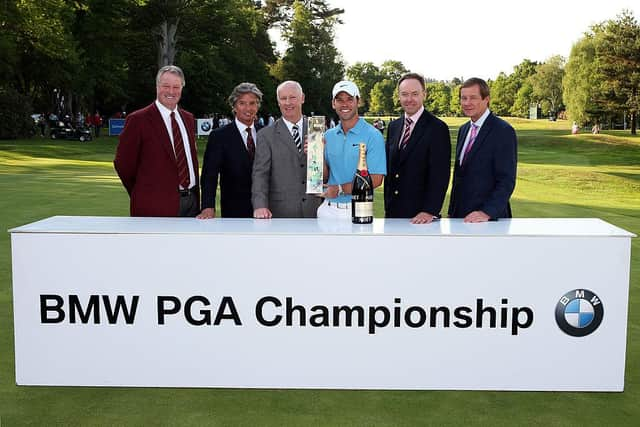Jim Farmer Q&A on playing for Hearts, teeing up in six Opens and his fears for Bryson DeChambeau


The 72-year-old Fifer won the Lytham Trophy and Leven Gold Medal as an amateur and played in six Open Championships, the first at St Andrews in 1970.
He succeeded John Panton as the Honorary Professional at Royal and Ancient Golf Club of St Andrews and was honoured by St Andrews University in a ceremony alongside Arnold Palmer, Tom Watson and Padraig Harrington.But, in this exclusive interview, he reveals that it could all have worked out very differently but for a career-ending football injury.
When did you realise that golf was going to be your career?


Advertisement
Hide AdAdvertisement
Hide AdJF: Well, it wasn’t as golf and football were side-by-side for me as a youngster and I eventually ran ahead with football. I played for a team in Cupar and then went to juniors at Newburgh and, before I knew it, I had signed for Hearts. When I went to Tynecastle, I was still able to get home to St Michaels, near St Andrews, by 3pm each day, so I was on the golf course for about 4pm.
How much of a thrill was it to be signed by Hearts?
JF: I received £500 for signing and, at that time, a house was about £4,000. So £500 for a 17-year-old was a big thing. I bought my own car for £99 and I felt wealthy, especially as I was still at school. I played centre-half and it was wonderful, but it all came tumbling down when I was 20 and had a knee operation and they took the cartilage out as it was a cruciate problem and I never really recovered. I went to Dundee for a short time, but every time I trained hard it just blew up due to the ligaments being damaged and I never really got that sorted until about 1983 when it began to bother me with my golf.
Who were some of your team-mates in that spell at Tynecastle?


JF: Donald Ford, who is still a pal, was there, as were Jim Brown, David Clunie. At that time, we were pulling in 25,000 fans at Tynecastle, though Hibs were in the ascendancy as they had the better team. They had Pat Stanton, Jimmy O’Rourke, those sort of guys, and we always had a battle against them. My football career was short and sweet, but I loved every minute of it before it all came crashing down and I was very lucky that I have only had a year in my life where I’ve not been in a sporting scenario for my job.
How did your golf career then take off?
JF: I had a year out from Tynecastle with Haig’s in Markinch. At a time when Ronnie Shade was with Vat 69, I was in the sales department and they were keen for me to play golf. It was a wonderful opportunity to keep my golf going as they allowed me to go away and compete in tournaments. I reinvented myself as a golfer within sort of 12 months, got my Scottish cap, won the Lytham Trophy, Leven Gold Medal and I was up and running as a pro in 1971. There was no money around at that time in the game, really. You also had to wait six months to actually earn money and, in 1971, I think I got £200 from the New Club in St Andrews and that would have done me for about two or three months on tour. Bed & breakfasts were £1-£1.50 and a gallon of petrol was two shillings.
What was life like as a touring pro in those days?


JF: It was all Monday qualifying before the European Tour was formed in 1974. My theory was that if you weren’t playing well enough to qualify, then there was really no point in being there and did pretty well in the Monday qualifiers. Of course, in those days there was no select gang of players who played together. It was an open draw and you could pull out Neil Coles, Tommy Horton or whoever. You were immediately playing with Ryder Cup players of the time, which was like being thrown in at the deep end. I remember playing with Tommy Horton and we had a coffee afterwards and he said I’d have got round 68 if I’d done this, this and this. That was the great learning thing at the time. Compared to a guy who gets a Scottish cap and how far away he is from any tour, it was like night and day.
What were the highlights of your time on tour?
JF: Firstly, the fact that I was still able to compete while doing so many other things. I remember playing in the Haigs Tournament at Dalmahoy with Howard Clark and outplaying him and also making the last day in the ‘Duel in the Sun’ Open at Turnberry in 1977. I was 19th going into the last round and 15th standing on the seventh tee. These are things a club pro nowadays can’t get near. It just doesn’t happen. Within a summer, I would only play in six to eight events as I was national coach and run a business at Duddingston that was turning over a lot of money. To do all that and still be able to compete on the European Tour when I got the boots on was marvellous.
You have had a very distinguished PGA career. How proud are you about that?
Advertisement
Hide AdAdvertisement
Hide AdJF: From a playing perspective, the Scottish circuit was started in 1975 and by 1976 I think we had about 70 pro-ams. I remember Billy Lockie phoning me up one day and saying, ‘you’ve just won seven pro-ams in a row’ and I’d put £10,000 in the bank, which was good money at that time. That was the beginning of something special in Scotland and we were the second tour. There was no Challenge Tour or PGA EuroPro Tour back then. Paul Lawrie did so well in Scotland and went straight on to the main tour. That was the stepping stone back then. That was the way you came through until the Challenge Tour started. The PGA did an awful lot of good stuff at that point in time in terms of events because all the clubs were receptive to pro-ams and it was easy for them to raise teams back then.
What are some of the other highlights of your career?
JF: I was PGA Cup captain at The K Club, where we won after a drought of 23 years, and I managed to win the British Club Pros’ Championship in 1983. I was also director of golf on two films. The first was Stroke of Genius with Jim Caveizel and Claire Forlani and the second, directed by Jason Connery, was Tommy’s Honour with Peter Mullins and Jack Lowden.
Was coaching something you were always interested in?
JF: Well, I enjoyed working with John Jacobs and I read all his books when I was an amateur. I had three lessons from John and everyone was better than the next. He made me understand the game as he wanted his pupils to understand their own swing and own game so they could go on the golf course and be in charge. I moved to Drumpellier in 1975 as the club pro as I wasn’t making enough on tour and Sandy Sinclair and Archie Fraser, who was the junior convenor for Scottish boys’ golf, was looking for a coach for his boys’ and youths’ team. I sat down and had a chat and I was the national boys’ and youths’ coach within about 12 months. It was a case of being in the right place at the right time.
Who did you enjoy watching come through the amateur ranks and go on to be successful as a professional?
JF: Well, I was so lucky because I had Bob McLaren from Largs as my convenor and he left me go and choose my squads. I picked up Andrew Coltart at 14, Gary Orr, Gordon Brand Jnr, Stephen McAllister and Stephen Gallacher. That system eventually broke down when the selectors decided they wanted to pick the squads. But it was a great thing to be able to pick someone who might not necessarily have had the best golf swing but had the best attitude or whatever. We had quite a good run at that time as two or three Scots were going on tour each year and being able to make a living. It’s a lot harder now, of course, because there are so many good players coming out of all the countries.
Did you also work with tour professionals?
JF: Because I was successful, I was able to retain people when they became tour pros. I worked with Stephen McAllister, Adam Hunter and Ross Drummond, as well as Paul Lawrie. At a time when Nick Faldo had David Leadbetter at his side all the time, Adam and Stevie wanted me to go on tour and that contradicted my whole philosophy about what I wanted them to be able to do, which was to be in charge of their golf swing. We didn’t fall out about it, but they moved on and I think they both ended up getting too much information at a time when they were actually very good players, so I think that back-fired on them.
Do you feel players these days can rely too heavily on their swing coaches?
JF: You see guys struggling in a round and they don’t have a strategy. They have to either phone their coach or hope he is there to fix it. The number of times you would play with Neil Coles and he’d go out in level par when things weren’t firing right and then he’d come back in 31 because he’d figured out what was going on.
Advertisement
Hide AdAdvertisement
Hide AdTell us about how your shop in the middle of St Andrews came about?
JF: I was the first to open a retail outlet on the high street and still be recognised by the PGA. I was able to get the brand outside the shop, though I think a change was coming anyway and a lot of pros these days, for instance, work for American Golf. We had nearly 20 years of running a wonderful business in St Andrews from 1987 to 2006.
As honours go, succeeding John Panton as the R&A’s Honorary Professional must have been pretty special?
JF: I think it was Christmas Eve when I got a letter from the R&A asking me if I would like to take over from John, who was the only honorary pro not to die in situ as he went down to live with his daughter near London before dying a couple of years later. I’d played with John in a lot of events over the years and had learned so much from him, both in terms of his demeanour and how he played the game. I remember playing with him at Turnhouse and he was round in 66 and I was 69 and you would be shaking your head and asking,’ how did that happen?’ He just had a skill to find the middle of the club. All that sort of thing was so great for a young lad like me trying to learn the game and get experience.
What does the Honorary Professional role entail?
JF: Well, it is one of the wonderful roles in life because it is one of the easiest roles to fulfil. Basically, it’s eating, drinking and being merry most of the time. The only real thing is playing in team matches and teeing up the incoming captain’s ball, which is something Old Tom Morris did way back. I’ve expanded the role a little bit so they allow me to help with the retail in the shop, which has done really well over the last few years.
Do you still like getting out for a game whenever you can?
JF: Yeah. I’ve got two new knees now. The game is not as good as it used to be for obvious reasons but I still love the thinking process of how to get a golf ball around the course. The feeling you get from the first tee to the feeling you get at the end are totally different most rounds and I still love the thrill of trying to figure it out.
The game continues to change, but do you necessarily like what you see?
JF: I hit the ball 230-240 off the tee and I was probably a wee bit longer than that when I was a young man. I can’t generate the speed the way they do with the modern size of head. With an old persimmon with a 7 degree loft, you would top it with every shot generating that sort of speed, the ball would never have got in the air. The iron play hasn’t really changed and the chipping and putting hasn’t changed. They are a lot better at it now because they understand it better. But the distance off the tee now is a million miles away from what we were trying to achieve with the equipment we had. I remember when I was at Duddington and a lot of guys came to me for lessons because they couldn’t hit a driver and could only play a 3-wood. The change in the size of a driver clubhead has allowed a lot of people to enjoy the game that would probably not even have come into the game if they didn’t have a 12.5 degree with a big metal head. But the problem now is the courses coping with the length.
Advertisement
Hide AdAdvertisement
Hide AdAre you worried about what Bryson DeChambeau might do on the Old Course in next year’s Open?
JF: I think if there’s a wind his action won’t work as well it can on some other courses. But I am worried about him full stop as the amount of action he puts into his swing, he just needs to injure himself a couple of times and he’s going to be in trouble. His left foot has to swivel out due to him changing his stance about 90 degrees through impact and he could end up breaking his left ankle as I don’t know if it is sustainable to do that. I prefer someone with an orthofdox, rhythmical swing and I am a bit worried about the guy and what he is putting himself through. Also, the time he takes over a golf shot, reading two books and figures out the wind, is getting embarrassing.
Do you feel lucky that your life has been steeped in golf?
JF: I was born in St Andrews and lived five miles away, so it was maybe going to be difficult for me not to have played golf. But the journey it has taken me on, from Ryder Cups, being on the board of the PGA, being captain of the PGA. My greatest thing was getting a St Andrews University award with Arnold Palmer, Tom Watson, Padraig Harrington and Johann Rupert. To have breakfast with Arnold Palmer and chat about his career while Tom Watson’s swing was the one I talked to people about when I was national coach. Things like that you just wouldn’t dream about. Unbelievable, really.
A message from the Editor:Thank you for reading this article. We're more reliant on your support than ever as the shift in consumer habits brought about by coronavirus impacts our advertisers. If you haven't already, please consider supporting our trusted, fact-checked journalism by taking out a digital subscription.
Comments
Want to join the conversation? Please or to comment on this article.
